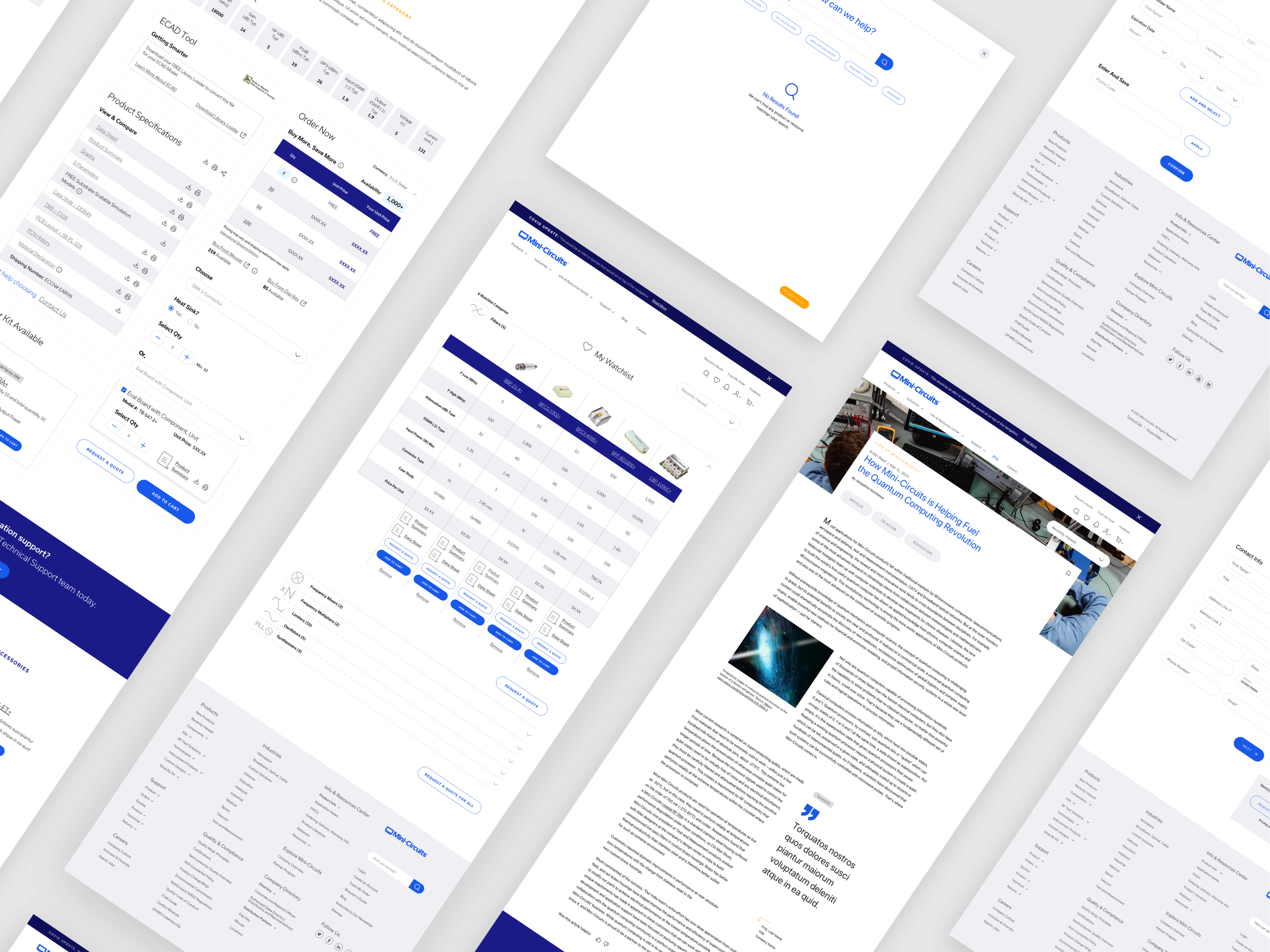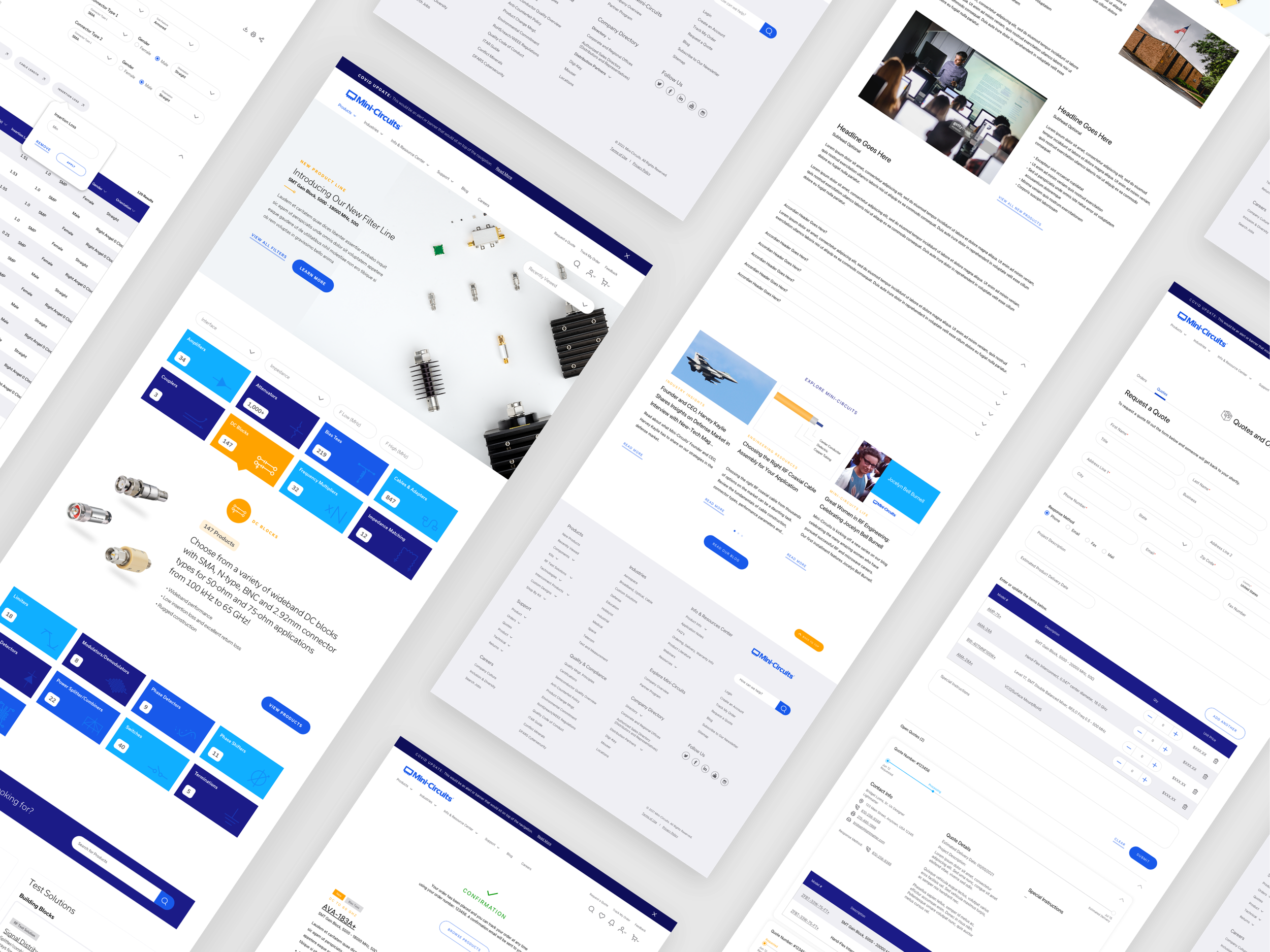Responsive eCommerce Website I B2B I Hardware
Increasing online orders and reducing support calls
Streamlined complex products using systems thinking, delivering significant cost savings, and reimagined the purchasing experience for engineers with a smart, modern approach that elevated the Mini-Circuits brand
BACKGROUND: Mini-Circuits is an innovative eCommerce company that leverages wave technology to design and develop hardware solutions for Fortune 500 companies worldwide, driving a faster, smarter, and more connected future.
2021
DURATION: 3 Months
PLATFORM: Responsive eCommerce Website
ROLE: Senior UX Designer, Lightmatter
SKILLS & METHODOLOGIES:
User Experience, Information Architecture, User Interface Design, Content Strategy, User and Stakeholder Interviews, Cognitive Walkthroughs, Requirements Gathering, Alignment Workshop, Lean Canvas Workshop, Lean Persona Creation, Prototype
TOOLS & FRAMEWORKS:
Sketch, Google Sheets, Google Documents, Miro, InVision
PROBLEM:
Mini-Circuits’ eCommerce experience was outdated, with an antiquated checkout process, poor user experience, and a cumbersome back-end architecture. Users struggled to find products and often resorted to calling customer service to make a purchase.
SOLUTION:
Lightmatter was tasked with designing a modern eCommerce experience that allowed users to easily purchase products, discover intelligent companion offerings, and elevate the Mini-Circuits brand.
OUTCOME:
Applied systems thinking to simplify complex products, we increased online orders, reduced support calls, and achieved significant cost savings
Indirectly impacted the ERP system, and improved overall operational efficiency
Full case study ~6 min read
Setting the Stage
Mini-Circuits, a global leader in wave-based hardware solutions, was ready to modernize its outdated eCommerce experience. Engineers struggled with product discovery, a clunky checkout, and poor backend performance — often resorting to support calls just to place orders. Lightmatter was brought in to rethink the experience from the ground up. In just 3 months, we applied systems thinking and user-centered design to create a smarter, more intuitive platform that streamlined ordering, reduced support calls, and strengthened the Mini-Circuits brand.
Problem
Mini-Circuits’ eCommerce experience was outdated, with an antiquated checkout process, poor user experience, and a cumbersome back-end architecture. Users struggled to find products and often resorted to calling customer service to make a purchase.
Solution
Lightmatter was tasked with designing a modern eCommerce experience that allowed users to easily purchase products, discover intelligent companion offerings, and elevate the Mini-Circuits brand.
DISCOVERY:
What We Did
We had 2 weeks to understand their business and marketing goals, product vision, and user problems and needs. We knew we couldn’t capture everything in 2 weeks, therefore our discovery and requirements definition continued throughout our process.
Planning
Understand Mini-Circuits' products and market
Identify stakeholders and organizational structure
Review documentation and analyze data
Conduct workshops to address gaps
User Goals
Easy product discovery, exploration, and comparison
Streamlined checkout process
Transparency in ordering and billing
Self-sufficiency in managing orders
Business Goals
Modern UX/UI and tech stack
Empower users with online ordering and order transparency
Integration with marketing systems
Key Learnings
Mini-Circuits is an industry knowledge hub, but there's room for improvement in areas like ERP, product comparison, and market positioning
The checkout experience needs significant enhancement
Constant communication and flexibility are essential for success
Automating order and billing updates will reduce reliance on support teams and improve the user experience
Users increasingly seek self-service options, and the website must evolve to meet these needs
APPROACH:
Delivering with Precision
After finalizing the website architecture, we developed a modular template strategy for efficiency and reuse. A design system was created for consistency across components. We designed wireframes for both desktop and mobile, then created high-fidelity mock-ups. Due to time constraints, we worked with Mini-Circuits’ engineers to validate the designs.
Key Deliverables
Roadmap with design sprints
Hypotheses and metrics
Sitemap, wireframes, and prototypes
Product-based content strategy
Scalable data analytics strategy
Detailed design system and module matrix
Baseline Metrics:
Reduction in Support Calls
Increase in Online Orders
Improvement in Customer Satisfaction Rates
3 Hypotheses
Self-Sufficiency
Enhanced product pages will help users validate and compare products, making them more independent and increasing online orders.
Efficiency
A persona-based dashboard will save users time and money by providing order visibility and management.
Satisfaction
Automated order communications will improve the user experience and increase satisfaction.
INSIGHTS:
Areas of Opportunity
Improved navigation and product search
Basic and advanced product filtering
ERP improvements
Product watchlist functionality

VISUALS:
Final Form
Hero Components
Bold product shots on every main page brings a modern edge and elevates the browsing experience
Cart
Easily manage and plan your projects straight from your cart
Product Discovery
Created multiple ways to browse products
Simplified Filtering Systems
A familiar yet frictionless, making it easy to use — saving users time
Mega Menu
Created clarity for reduced cognitive load and improved product discovery
Design System
Developed a system of components and patterns for consistency and reusability
Watchlist
Enabled users to save and compare products side by side for easier decision-making
Product Pages
Key specs and critical details were surfaced at the top of each product page to support faster, more informed decisions
Order Tracking Module
Centralized order tracking gives users instant visibility into their purchase status — and reducing customer support calls

RESULTS:
Shaping Bold Outcomes
Indirectly impacted the ERP system, and improved overall operational efficiency
Applied systems thinking to simplify complex products, and we increased online orders, reduced support calls, and achieved signifigant cost savings













